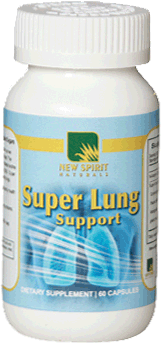
Super Lung
- Beneficial for those with breathing difficulties, asthma and allergies.
- Helps lung function and decreased frequency of COPD symptoms.
- Increases glutathione, the body's most potent antioxidant to help with proper lung function.
- Protective aid against environmental pollution factors.
As we age, our lung cells die off faster than they are replaced. Super Lung Support provides support for healthy lungs with N-Acetylcysteine (NAC) and a proprietary blend of Cordyceps, Mullein Leaf, Marshmallow Root, Astragalus, Licorice, and Ginger.
NAC is essential for pulmonary and renal protection according to the World Health Organization. Along with cordyceps which support epithelial cells in the lungs and the herbal blend providing anti-viral, anti-inflammatory, and anti-microbial benefits for lung support.
60 capsules
Retail $39.95 / Your Cost $29.96
|
 |
|
|

|

Respiratory Impairment (Lung Power) is a significant predictor of coronary heart disease (CHD) and cardiovascular disease (CVD) as well as cause mortality. Our respiratory system undergoes various anatomical, physiological and immunological changes with age. Our lungs mature by age 20-21 years and thereafter is associated with progressive decline in lung function.
What Happens As We Get Older.
- The diaphragm, the large muscle that moves air in and out, gets weaker decreasing the ability to inhale and exhale.
- Ribcage bones become thinner and change shape altering our capacity to expand and contract dur-ing breathing.
- We experience decreased elastic recoil and in-creased stiffness of the chest wall.
- Alveoli (small sacs) whose exchange of oxygen and CO2 happen with the bloodstream, can lose their shape and become baggy.
- The part of the brain that controls breathing may no longer send as strong or clear of a signal to the lung.
- Lung tissue becomes damaged due to foreign particles and pollution, smoke, etc.
- As we age, cells in the lung begin to die off faster than they are replaced.
What does lung power mean to you health?
- Framingham Heart Study – discovered that the state of your lungs is the No. 1 indicator of how long you will live. Put another way, it's the No. 1 Predictor of Death.
- American College of Chest Physicians – even moderately impaired lung power increases your risk of death.
- Denmark- the Copenhagen City Hearts Study found that a loss of lung volume raises the risk of first time stroke by more than 30% and triples the risk of suffering a fatal stroke.
- European Society of Cardiology – reports a moderate decline in lung volume increases your risk of heart disease by 200%.
- A 7 1/2 year study at Royal Free Hospital of Medicine in London revealed that even moderate loss of lung power doubles your risk of heart attack.
- New Zealand (University of Otago) discovered that people with smaller lungs have higher levels of c-reactive protein (CRP) the key marker of inflammation.
- The higher your levels of CRP the greater your risk of heart attack, stroke and hardening of the arteries.
Super Lung Key Ingredients
N-Acetylcysteine (NAC).
The World Health Organization (WHO) indicates that NAC is essential for pulmonary and renal protection and anti-microbial uses. NAC has been used with success in respiratory conditions for many years. Current literature suggests that NAC is a tissue-specific antioxidant. In pulmonary disease (COPD) excessive infiltration of pro-inflammatory cytokines and lymphocytes trigger massive up regulation of potent reactive oxidative species. As the delicate tissues of the pulmonary alveoli are subjected to this toxic stimuli year after year, the body gradually loses its ability to compensate and lung function declines.
Additional Uses:
N-Acetylcysteine exhibit potent anti-mycobacterial activity in addition to its known anti-oxidative functions. Due to its disulfide reducing activity NAC is used as mucolytic agent to promote expectoration.
Cordyceps Sinensis.
COPD is a progressive disabling illness associated with an abnormal inflammatory response of the airways and the lungs to noxious stimuli. It is characterized by persistent airflow limitation that is not fully reversible and excess inflammation. These same researchers showed that Cordyceps sinensis can inhibit the CSE- induced senescense.
Marshmallow Roots (Althaea officinalis).
Marshmallow Root has a long history in folk medicine that goes back over 2,800 years ago to ancient Greek and Egyptian times where it was used as a popular way to treat coughs, sore throats, congestion, break up mucus and reduce inflammation and kill bacteria naturally. A study published in the Journal of Ethnopharmacology found that the compounds in marshmallow help reduce symptoms like pain and swelling within the nasal passages, the mucous membranes that line the respiratory track and the lining of the digestive systems.
Licorice (Glycyrrhiza glabra) GL.
Folklore has noted it's life-enhancing properties. Now science has shown it to have functions of nourishing chi, alleviating pain, fortifying spleen and stomach, eliminating phlegm and relieving coughing. Viral and other microbial infections play a critical role in many highly prevalent diseases. Some studies have demonstrated that GL showed a significant inhibiting effect to the influenza virus.
Astragalus (a membranaceus).
Astragalus is a natural plant based ingredient used for various health conditions. In Chinese medicine, it is said to stimulate the spleen, liver, lungs, circulatory and urinary systems and to improve overall weakness. Modern research has found it to have a protective effect on the lungs (lung chi or lung energy).
Ginger.
Taking ginger might help improve lung functions by increasing the lung capacity (which is the volume of your lungs after maximal inspiration). People with chronic lung diseases such as asthma and bronchitis, encounter a faster loss of lung capacity.
References:
- Adapted from Ware JH, Dockery DW, Louis TA, et al. 1990. Longitudinal and cross-sectional estimates of pulmonary function decline in never-smoking adults. Am J Epidemiol, 132:685-700. Copyright © 2004. Reprinted with permission from Oxford University Press. Source: Bio Med Central – Research article – Open Access.

